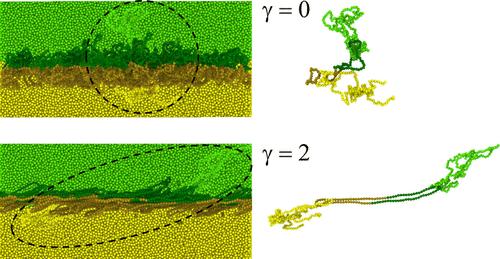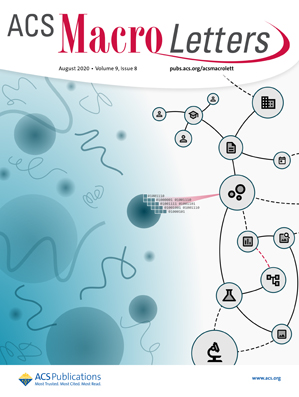二嵌环作为不相溶聚合物界面的拓扑粘合剂
IF 5.2
Q1 POLYMER SCIENCE
引用次数: 0
摘要
互不相溶的聚合物往往不能很好地混合,由此产生的互不相溶界面在机械性能上弱于主体,这在许多技术应用中都是不可取的。本研究进行了大规模分子模拟,以证明二嵌环聚合物作为不相溶聚合物界面的新型粘合剂的有效性。随着二嵌环长度和覆盖率的增加,剪切变形时的峰值应力 σp 和破坏应变 γp 都接近块体值。将二元共聚物环拆分成一对对的二元共聚物线性链可作为比较的参照系统。在覆盖率相同的情况下,二嵌环比二嵌线性链增加了 σp 和 γp。基于高斯链接数的进一步拓扑分析表明,二嵌环与来自相反两侧的线性链的穿线是增强粘附力的关键机制,这类似于魔术贴中的钩环过程。本文章由计算机程序翻译,如有差异,请以英文原文为准。

Diblock Rings as Topological Adhesives at Immiscible Polymer Interfaces
Disparate polymers often do not mix well, and the resulting immiscible interfaces are mechanically weaker than the bulk, which is undesirable for many technological applications. Large-scale molecular simulations are performed to demonstrate the effectiveness of diblock ring polymers as a new type of adhesive for immiscible polymer interfaces. The peak stress σp and the failure strain γp upon shear deformation approach the bulk values with increasing diblock ring length and coverage. Breaking the diblock rings into pairs of diblock linear chains creates a reference system for comparison. The diblock rings increase both σp and γp compared to the diblock linear chains at the same coverage. Further topological analysis based on the Gauss Linking Number reveals that the threading of diblock rings by linear chains from the two opposite sides is the key mechanism for stronger adhesion, which is analogous to the hook-and-loop process in Velcro tape.
求助全文
通过发布文献求助,成功后即可免费获取论文全文。
去求助
来源期刊
CiteScore
10.40
自引率
3.40%
发文量
209
审稿时长
1 months
期刊介绍:
ACS Macro Letters publishes research in all areas of contemporary soft matter science in which macromolecules play a key role, including nanotechnology, self-assembly, supramolecular chemistry, biomaterials, energy generation and storage, and renewable/sustainable materials. Submissions to ACS Macro Letters should justify clearly the rapid disclosure of the key elements of the study. The scope of the journal includes high-impact research of broad interest in all areas of polymer science and engineering, including cross-disciplinary research that interfaces with polymer science.
With the launch of ACS Macro Letters, all Communications that were formerly published in Macromolecules and Biomacromolecules will be published as Letters in ACS Macro Letters.

 求助内容:
求助内容: 应助结果提醒方式:
应助结果提醒方式:


